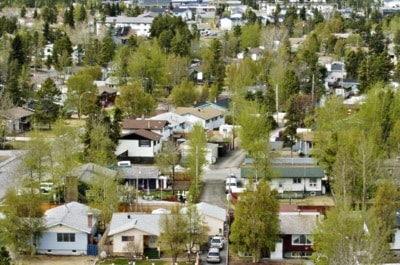Radon, a “Class A human carcinogen,” has been leaking into homes in Wolf Creek and other Yukon neighbourhoods silently and undetected for decade.
Health Canada will soon announce a reduction in its guideline for acceptable radon concentrations in homes from 800 becquerels (a measure of radioactivity) per cubic metre of air to 200 Bq/m3.
The change in danger-zone radon levels comes at the recommendation of a panel of federal and provincial health and nuclear safety experts. It will bring Canada’s policy in line with international norms.
The US has one of the strictest guidelines already, 150 Bq/m3 as mandated by the US Environmental Protection Agency.
Canada’s new recommended limit of 200 Bq/m3 reflects regulations in effect in a dozen other countries including China, the Czech Republic, Australia and the UK.
In-the-know homeowners like Yukoner Grant Abbott had their basements tested in the mid-1990s when they first heard rumblings about in-home radon levels.
In the Wolf Creek home he sold in 1999, Abbott found levels that were 12 times higher than the old guideline set in 1988.
“It was one of the highest levels ever recorded. Really high,” said Abbott.
This month, in his role as director of the Yukon Geological Survey, Abbott has been working with the Yukon Housing Corporation to generate a map of sites with potentially high radon levels.
The data set is compiled of radon readings gathered from voluntary testing undertaken by homeowners since the mid-‘90s.
“At this point we know where the hotspots are in Whitehorse, but why they’re there is not entirely clear,” he said.
So far, three neighbourhoods have emerged as areas of particular concern: Wolf Creek, Pineridge and Porter Creek.
“It seems that certain areas of Whitehorse tend to have higher levels than others,” said Juergen Korn, a project manager with Yukon Housing.
“Some have very low levels. It depends on the geology, and on the construction of the house,” said Korn.
But just because a person may live in a problem neighbourhood, it doesn’t follow that the soil under their house leaks radon, or that the radon is collecting inside the home, he added.
“One person could have a very high level, and their next door neighbour may not,” Korn said.
The Canadian Radon Working Group recommends that homeowners take remedial action in any dwelling in which the average annual radon concentration exceeds 200Bq/m3.
Community and industry development staff working with the Yukon Housing Corporation stress that this is not an urgent situation.
“We don’t want to create a sense of panic,” said director Al Lyon.
“If you’ve got a radon problem — if you even think you’re in an area with a radon problem — you’re not going to drop dead next week. That’s not how it works,” Lyon said.
Radon is an invisible, odourless, non-flammable gas that is a byproduct of uranium decay.
Radon leaches through porous soils and sometimes into homes along pipes and through cracks, where it can collect and concentrate in under-ventilated spaces — usually in basements and crawlspaces.
Though heavier than air, radon becomes a problem in energy-efficient homes during the winter when the warm interior effectively sucks radon out of the basement and tightly sealed doors and windows keep the radioactive gas trapped inside.
The health risks, while not imminent, are severe.
Though not associated with persistent coughs or headaches, radon does cause lung cancer.
“Other than lung cancer, it has not been associated with any other form of cancer or health risk,” asserted Dr. Bryce Larke, Yukon’s Medical Health Officer.
“It’s simply the fact that these particles that break down — these radioactive particles — do get inhaled into our lungs, and over a period of long time produces tissue damage, and can set the scene for cancer just as how inhaling cigarette smoke produces that effect.”
The radon working group’s report states that radon exposure accounts for 10 per cent of all lung cancers.
Based on recent analysis of 13 European studies and seven North American studies and known cancer rates for uranium miners, the radon working group calculated your risk of developing lung cancer based your smoking status and on your average long-term radon exposure.
“In general, the risks from radon exposure are one to several orders of magnitude higher than what would be considered acceptable for exposure to manmade radiation or chemicals in the environment,” said the group’s 2006 report.
A lifetime exposure to radon at a level of 800Bq/m3 puts you at a one-in-three risk for developing lung cancer if you’re a smoker, and one in 20 if you are a non-smoker.
Under the new guidelines of 200 Bq/m3, that risk drops to below one in five for smokers and one in 50 for nonsmokers.
A lifetime exposure to ambient outdoor radon levels, about 10 Bq/m3, results in a lung cancer risk factor of just over one in 10 for smokers and one in 100 for nonsmokers.
“There’s no question that the smoker is at a greater risk,” Larke confirmed.
The report estimates that 1,589 people died in Canada in 1997 from radon-attributable lung cancers.
In 1997, radon deaths equaled the combined totals for accidental poisonings (703), homicides (440), drownings (283), and fires (272).
The number of deaths from to radon equaled half of the deaths from motor vehicle accidents.
“In any other situation, this number of deaths would certainly justify a major public health initiative,” the report stated.
Part of a series.
Next week: Find out how to get your home tested (for free) and why you might want to hold off until the winter. Plus, how much does it cost to fix a radon problem?
Also upcoming: controversial reports suggest Health Canada’s new radon guidelines still aren’t strict enough.
